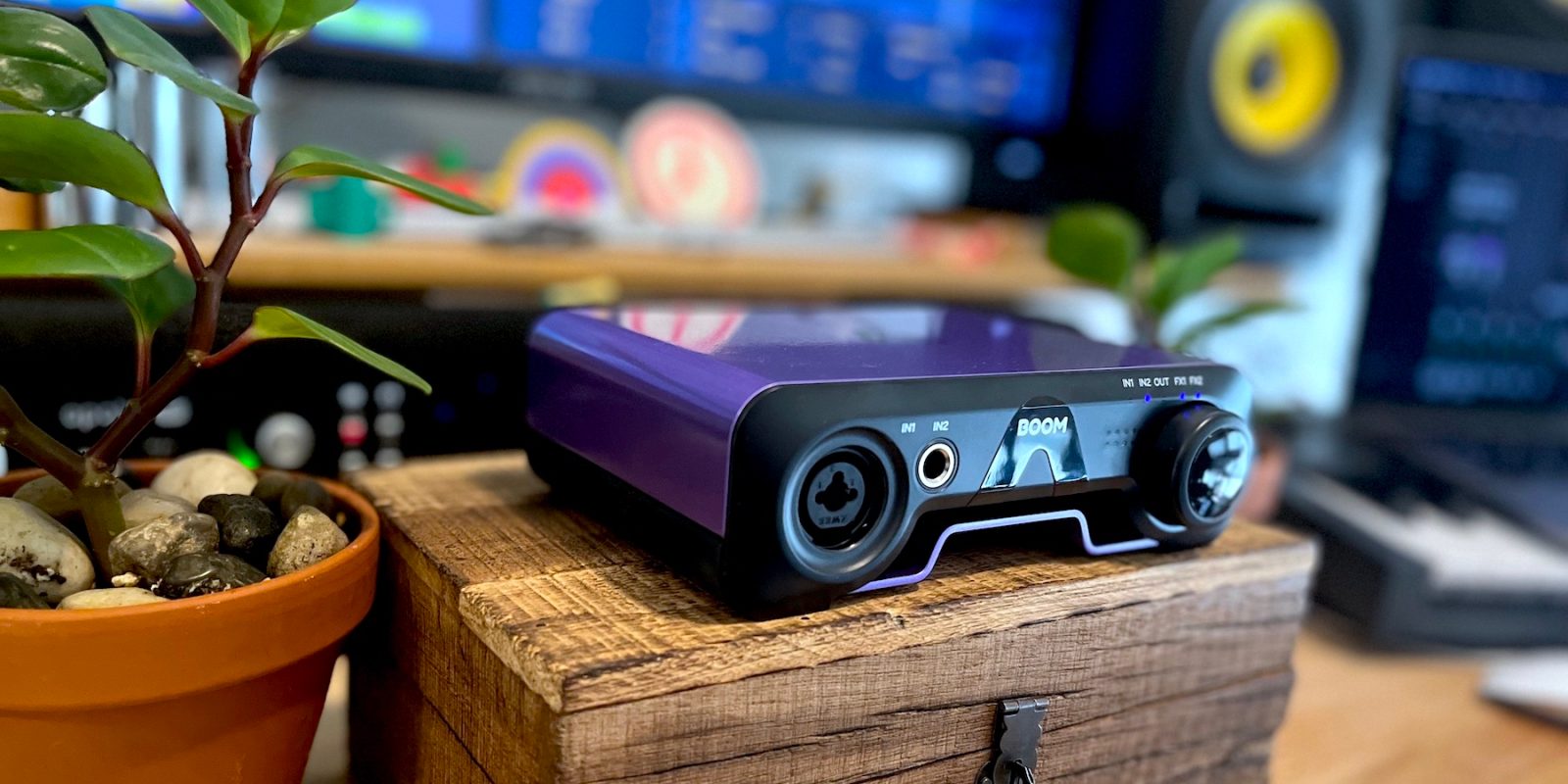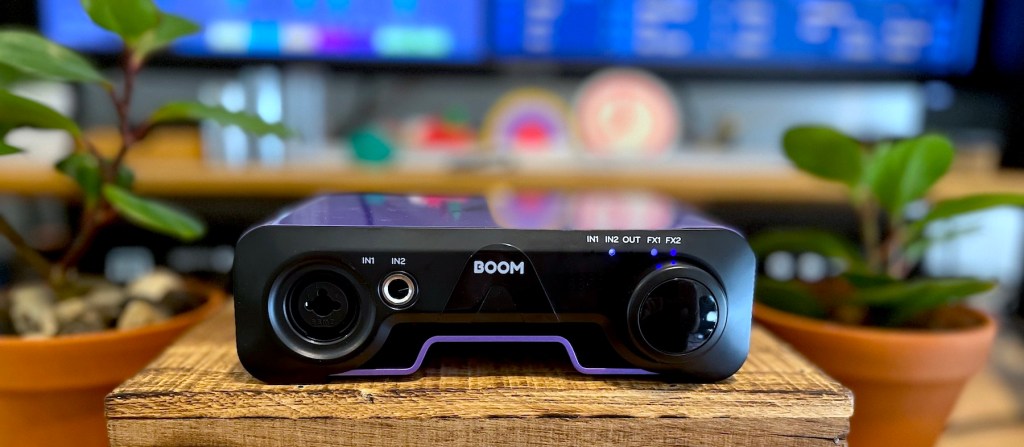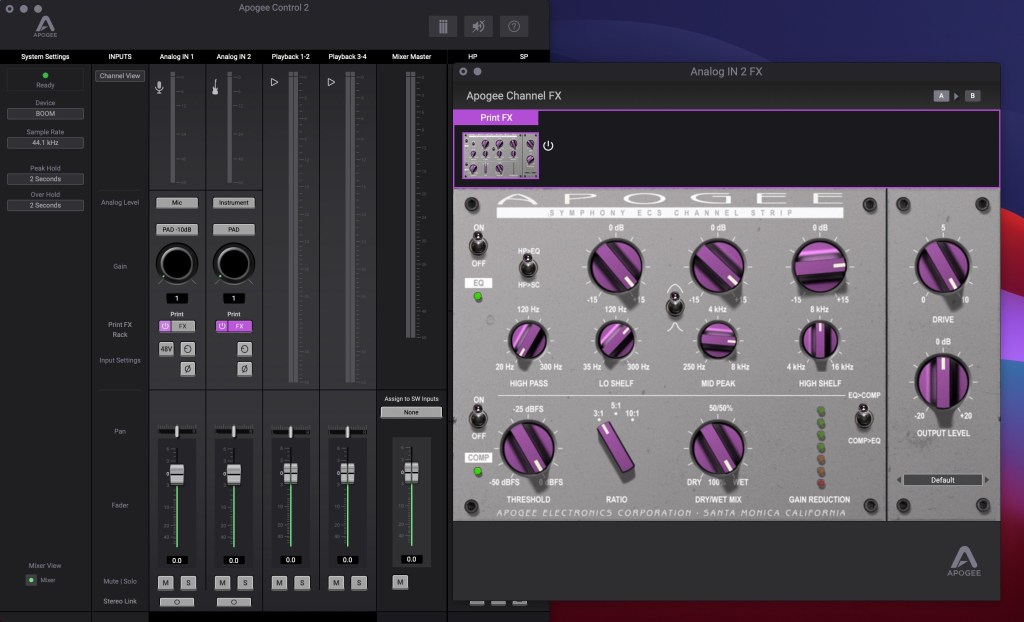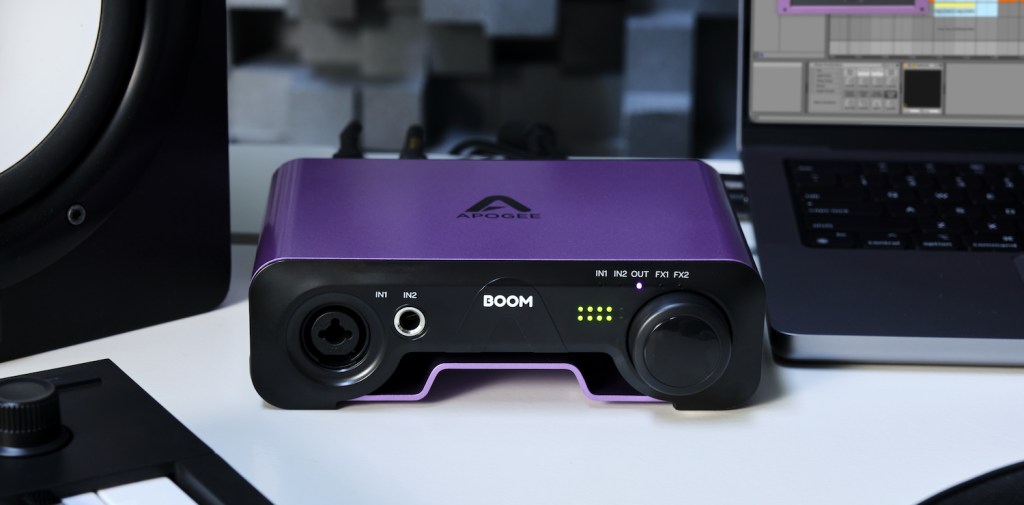
Apogee, a leader in the digital audio space, is unveiling one of its most exciting and capable entry-level pieces of kit today, the Apogee BOOM audio interface. While not exactly known as the most affordable solution out there, they are best known in professional circles for its high-end consumer recording studio models; the brand has also been delivering top-notch interfaces and USB mics for content creators over the last several years now with gear like its Duet line and MiC Plus. But things are getting really interesting today with the announcement of its most affordable dual-input BOOM interface. After having a chance to go hands-on with an early production unit over the last few weeks, we are ready to dish up an in-depth look at this powerful little recording device.
Apogee BOOM audio interface review
Apogee BOOM – the “first audio interface in its class to offer hardware DSP + Native plugin workflow” – is the brand’s most affordable two-channel model ever. It is a 2×2 audio interface for home music producers, podcasters, streamers, and really anyone needing to connect an XLR microphone or instrument to a Mac, Windows machine, iPad, or iPhone. (An additional Lightning adapter is needed here as usual.) The new Apogee BOOM will retail for $299.
I/O and controls
Sporting a front-mounted combination mic/line/instrument jack, BOOM also features an additional 1/4-inch instrument/line input. Around back, you’ll find the 1/4-inch zero-ohm headphone output and a pair of left-right speaker outputs alongside the USB-C power/data port – this is a portable bus-powered machine. You’ll also find one of those Kensington lock connectors.
The front panel also houses a large multifunction control knob for adjusting input levels on both channels and speaker output volume. You simply press the knob in with a satisfying click to flip through the various functions – a simple, intuitive, and effective way to control the most important features of the interface. It might not have the massive top-mounted, in-your-face control like its entry-level models of the past, but it still delivers on much of that experience with the new setup.

For any of you technical folks, here are the spec ratings for the mic pre, Hi-Z input, and converters on Apogee BOOM:
Mic pre:
- EIN: 128dB (unweighted) @ 62dB, 150 ohm input
- Max Input Level: +18dBu
- Input Impedance: 2.4K ohm
Hi-Z:
- Max input level: 18dBu (active), 8dBu (passive)
- Input Impedance: 3.2K ohm (active), 1M ohm (passive)
A/D conversion:
- Max input level +4dBu: +18dBu
- Max input level (-10dBV ref): +6dBV
- Input impedance: 6.4K ohm
- Frequency response 20 Hz -20Khz: > +/-0.2dB (@44.1Khz)
- Rel. THD + N: -100dB
- Dynamic Range: 122dB (A-weighted)
D/A conversion:
- Max output level (+4dBu ref): +15dBu
- Line output impedance: 100 ohm
- Max output level headphones: 15dBu
- HPH output impedance 0.5 ohm
- Frequency response 20Hz -20 Khz: > +/- 0.05dB
- Rel. THD+N : -107dB
- Dynamic Range: 117dB (A-weighted)
Build
Apogee has never disappointed with the overall physical build of its gear for me, and the new BOOM interface is no exception. While the brand has strayed from the sort of desktop-style, top-mounted controls found on many of its more entry-level devices of years past, it is continuing to deliver a solid, rugged-feeling box that can handle road trips and looks great in your setup at home.
The sort of two-tone black and vibrant purple paint job here scream Apogee around every curve of the more traditional form factor, while an angular, almost floating bottom plate delivers a more modern look and feel. This gap along the bottom can also come in handy for folks looking to run cables around back of the device. The subtle embossed logos on the top and front of the machine are a nice touch as well.
Apogee BOOM is surrounded in the aforementioned purple metal chassis with rubberized padding across both ends resting against the tabletop. The large multifunction knob on the front panel, combination XLR, 1/4-inch input/output jacks, and inset bus power/data connection USB-C port are all solid and free of that annoying loose wiggle you might find on inferior products.

Apogee BOOM Hardware DSP + Native plugin workflow
As we mentioned above, the Apogee BOOM delivers what the brand refers to as the first and, as of right now, only interface in its class with a hardware DSP and native plugin workflow, according to the brand. What that essentially means for the uninitiated is that you can make use of Apogee’s multi-FX Symphony ECS Channel Strip to apply and print FX on the recording path or enhance the sound of your vocals and other recordings after the fact like a typical plug-in. Just keep in mind, you’ll have to purchase the native plug-in version for your DAW after the fact. (It is 50% off when you register your new BOOM.) It features classic-style EQ based on vintage 1970s hardware, compression with parameters tuned by legendary mixer Bob Clearmountain, and a particularly sweet saturation to introduce everything from subtle warmth to full-on crunchy distortion.
Symphony ECS Channel Strip, the same one included with its far more expensive interfaces, is nothing vets of the DSP space haven’t seen before, but it is a great example of these bread and butter multi-FX units and sounds fantastic to my ears.
It is also a solid option for entry-level users that allows for the subtle compression I find most podcasters and content creators are after via an interface that won’t overwhelm folks who don’t know or care about side-chain detection circuits, advanced attack/release settings, and verbiage sometimes found on purist vintage compression emulation. The range of quick-select presets for everything from drums and guitars to vocals and more make things even easier. The mixing console and software control station is where you get virtual controls for things like input gain, engaging the Symphony ECS Channel Strip, and enabling phantom power, among other things. These and the quick-select presets are part of the experience here and are, to no surprise, solid integrations that enhance the overall experience.

From digital audio pioneers to state-of-the-art content creator rigs
For those unfamiliar here, Apogee is not only an industry leader in the digital audio space, but it, in many ways, was a pioneer in the world’s transition from purely analog recording to digital-based workflows. It was founded in 1985 – initially to develop products like its anti-aliasing filters to enhance early digital recording devices from Sony, Mitsubishi, and Yamaha – and has, in part, set the standard for analog-to-digital and digital-to-analog technologies ever since. The brand has armed professional recording studios across the globe with its interface products for nearly 50 years now, and in recent years, also launched products for home music producers, podcasters, and content creators of all types with its Symphony and Duet interfaces as well as the Apogee HypeMic with built-in analog compression.
Enter Apogee BOOM
With its latest Duet 3 and Symphony Desktop interface, alongside the far more pricey high-end pro solutions, the brand also stepped into the world of DSP processing, delivering its customers world-class hardware-powered FX to further enhance its mission to bring that warm, professional analog sound to digital recording on Mac, iPad, iPhone, and Windows machines. Prior to today, the entry price for this tech wouldn’t exactly be considered affordable by your average home studio owners, weekend recording warriors, or entry-level internet broadcasting setups. But that’s where the new Apogee BOOM comes in.

Interfaces can sometimes be a pricey necessary evil to some folks that want the sound quality of a proper XLR microphone as part of their setup. We are not all audio gear geeks, and having to add that extra bit of kit as well as the expense that comes with it will certainly make some content creators reach for the more affordable USB-C microphones, bypassing the interface altogether. However, I for one, love having a single interface that provides a hub for all the audio coming in and out of my machine (not to mention a pair of physical 1/4-inch or XLR jacks to connect what I would consider proper speakers), be it iPad Pro or the Mac-based desktop rig, for full control over my audio input/output devices.
While Apogee’s solutions have always been on the top of my recommendation list, not everyone is willing to dish out the cash for the models that deliver this functionality. However, with the new digestible price tag and easy-to-use DSP sound enhancement features, everyone in the 2×2 sub $300 interface market should have the Apogee BOOM on their radar if you ask me.
Buy the Apogee BOOM interface.
FTC: We use income earning auto affiliate links. More.







Comments